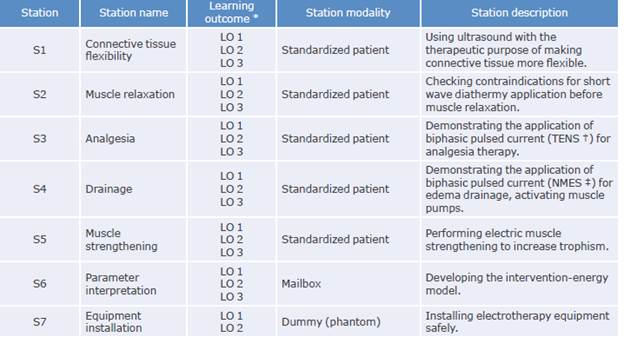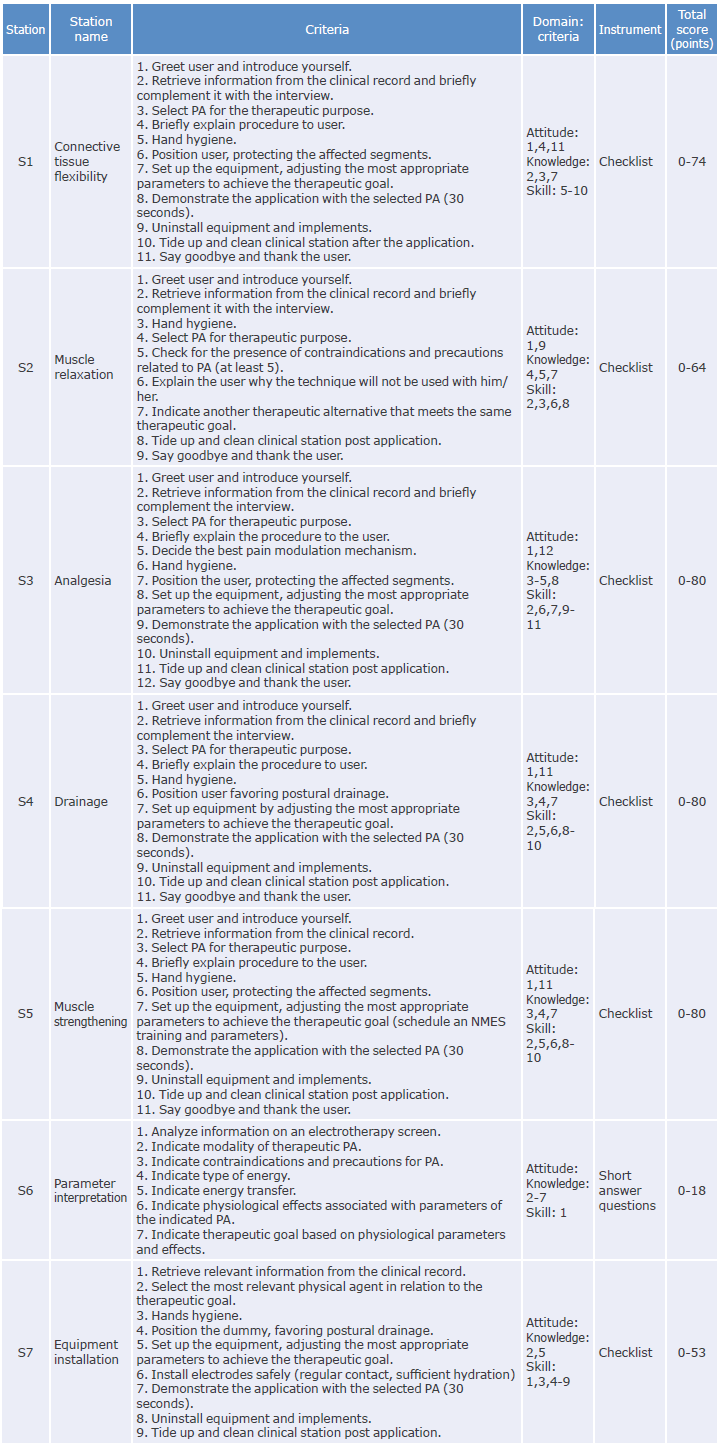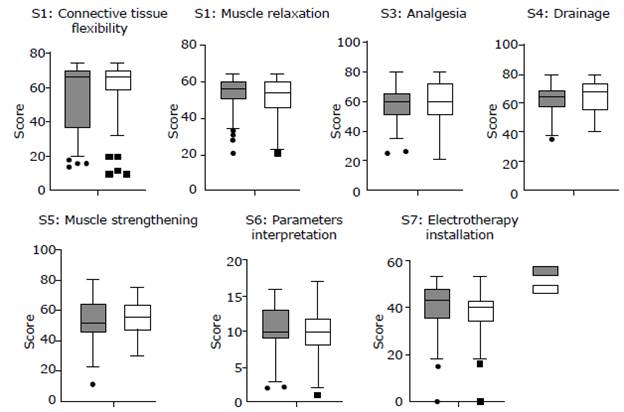Introduction
Health education is a complex activity that requires integrating knowledge, skills, attitudes and values to train professionals, not to mention a dynamic teaching process based on the context, socio-cultural changes, and emerging needs.1 Training for healthcare professionals entails the use of a methodology that involves the development and assessment of professional skills that enable them to solve problems inherent to their profession in a specific context by applying their knowledge on professional functions, tasks, and attributes associated with social development demands.1
Higher education has focused its formative models on learning-centered teaching, that is, the educational practice that aims to teach and promote the development of critical skills emerging from the needs, interests and abilities of students.2 Student-centered training focuses on learning, so that students assume a more active, self-directed role in their training, thus making the teacher a facilitator of the process instead of a lecturer.3-5 This approach implies a paradigm shift that leads to the use of varied teaching and evaluation methodologies, especially to develop clinical skills.6-8
Physical therapy training processes are oriented to the development and acquisition of learning outcomes (LO), which requires instructional methods focused on what the student needs to learn, making them aware of the knowledge necessary for professional practice.6-8 LOs are usually defined as the set of knowledge, understanding and actions that a student is capable of demonstrating at the end of a training and learning period. The term LO includes the skills, attitudes and understanding that the student obtains and, therefore, is able to demonstrate as a result of an educational experience, and that are required to prove their level of compliance with said experience.9-12
Other authors have defined LOs as a combination of generic and discipline-specific skills, as well as an integration of knowledge and attitudes that the student will achieve.9,13,14 LOs also describe how and under what conditions students will be evaluated, allowing the identification of the results of a study program, as well as the evaluation criteria that will be used.9-12,15,16 A variety of LO classifications have been proposed in the literature; however, there is consensus that they correspond to what a student knows and is able to do as a result of a learning process, recognizing that LO-based education has evolved in the context of the training of health professionals.7,9,10-18
The application of physical agents is a requirement for physical therapy undergraduate students, as the development of this clinical skill is a fundamental part of the physical therapy study plan. Physical agents comprise natural or artificial resources including heat, cold, water, electricity, and electromagnetic radiation for therapeutic purposes.19-24 Although there is no common frame of reference for the physical therapy profession that defines the ability to apply physical agents and the level of achievement, it has been recognized as "the evaluation and use of physical agents in clinical practice," which implies a deep knowledge of their physiological effects for the different forms of energy used.24,25
The use of physical agents requires that physical therapy professionals understand properly their contraindications, precautions, and indications, as well as being duly informed about their application and relevance in specific contexts. An inadequate choice could generate unwanted effects in patients such as pain, burns, skin lesions, pregnancy hazards, and bleeding, among others.22,23 Thus, an adequate physical agents intervention assessment requires pedagogical practices and evaluation strategies that favor the resolution of clinical problems in real physical therapy scenarios.25,26
One of the greatest challenges of training physical therapy students is the assessment of professional skills in intervention areas using objective, valid, and reliable instruments that guide the formative processes towards experiential processes. In this context, clinical simulation provides students with frequent exposure to controlled risks, error tolerance, and learning experiences transferable to clinical practice.7,8
The structured objective clinical examination (OSCE) is an example of these simulation strategies. OSCE is a pedagogical instrument that includes several evaluation methods in the same test; it is a methodology described in the literature that facilitates the development of clinical skills.27-30 Different studies have given value to this instrument, demonstrating that OSCE is a good methodology for evaluating clinical skills with adequate indicators of validity, objectivity and reliability. 31,32 The OSCE format is geared to assessing clinical skills and professional attitudes in context-specific situations, differing from theoretical evaluations that mostly seek to assess knowledge.33
During the implementation of the OSCE, students rotate through a sequential station circuit, where they are asked to perform several activities that require procedural and reasoning skills. Stations use standardized simulated patients, computer cases, dummies, complementary tests, and multiple-choice or short-answer questions related to clinical cases, among others.26-28 Various training experiences with the OSCE methodology in other healthcare professions highlight it as an appropriate and valuable instrument that increases students' skills and knowledge of their field.34-36
Therefore, the OSCE methodology can be useful to measure the LOs of physical therapy students when using physical agents, minimizing risks, and improving the therapeutic care offered. To date, there are no publications on the use of this type of methodology to assess the clinical skills of physical therapy students when using physical agents that compare results between sexes.
Thus, the objective of this study was to implement the OSCE methodology for the assessment of clinical skills in physical therapy students when using physical agents.
Materials and methods
Ethical considerations
The present study was approved by the Bioethics Committee of the Faculty of Rehabilitation Sciences of the Universidad Andrés Bello and followed the principles of the Declaration of Helsinki (Certificate A161, approval June 3, 2019).37 Before taking part in the study, all participants were required to sign an informed consent form.
Participants
The study included 114 students (59 men, 55 women) enrolled in the physical agents course of the Physical Therapy program offered at Universidad Andrés Bello in Santiago de Chile, Chile. The study was carried out in the Faculty of Rehabilitation Sciences, Laboratory 304, Building C5, at the Casona de Las Condes Campus of UNAB, Fernández Concha 700, Santiago, Chile.
The inclusion criteria considered all the students who were taking the physical agents course during the first semester of 2019 and who consented to the use of their information regarding the scores. Students who did not perform or did not complete the test were excluded from the study. Of a total of 118 students, 4 were excluded.
Instrument
The OSCE methodology was presented to students at the beginning of the semester, together with several evaluation strategies such as the biannual closing evaluation.
The OSCE was designed by physical agents professors in accordance with the institutional educational model, which establishes that training should be based on LOs. The LOs described in the course program included: 1) the ability to analyze physical and physiological results derived from the application of non-ionizing physical agents; 2) the evaluation of different non-ionizing physical agents modalities in terms of the therapeutic objective in different professional contexts and the resolution of deficiencies and problems with the functioning of the users due to various health conditions; and 3) the evaluation of deficiencies and functioning problems originated by the users' health conditions, as well as the relevance and context of intervention with non-ionizing physical agents.
For 3 months, students received weekly preparation sessions that covered the biophysical bases, physiological effects, and the most used applications of physical agents, with an emphasis on biphasic pulsed current (TENS), Russian currents (Kots), short wave diathermy (SWD), and conventional ultrasound. Training was carried out with practical laboratory activities, resolution of clinical problems, and simulation stations among the students themselves. The OSCE was divided into 7 stations to evaluate the LOs defined for the physical agents course (Table 1).
Table 1 Physical agents, OSCE stations, and clinical skills evaluated.

* Learning outcomes established for the physical agents course.
† Transcutaneous electrical nerve stimulation.
‡ Neuromuscular electrical stimulation.
Source: Own elaboration.
The OSCE stations were built to replicate common clinical problems in Physical Therapy. A rest station was assigned between stations 5 and 6. Each station lasted 8 minutes (1 minute for instructions and 7 for the application), with a total of 64 minutes for the exam. Before the OSCE began, instructions regarding the time, number of stations, and rotation direction were given. A professor checked the time and indicated the moment and form of rotation to the students. Before its application, the OSCE was submitted to peer evaluation by 5 physical therapists, with a focus on the station checklists and their consistency with LOs. After peer validation, the acting team (5 standardized patients) was summoned and a pilot test was carried out with the physical agents course professors and 8 students who had already taken and passed the course, as well as with observers to complete the training in their respective stations. It should be noted that adjusting the instrument after the peer validation process and the pilot test was not necessary.
Students were divided by the PA professors into 14 groups of 8 people and were assigned a day and time to take the test. Two days were considered for the OSCE application.
Stations S1, S2, S3, S4 and S5 had standardized patients (previously trained and assigned with hea conditions), while a dummy was used in S7; station S6 (mailbox) involved the interpretation of electrotherapy equipment parameters. Each station was evaluated with a checklist that included criteria in attitudes, knowledge, and skills domains (Table 2).9-12,15
A trained observer with the checklist was assigned to the 6 stations to verify compliance or not with the criteria established for each station. Interaction between the observer and the students was not allowed.
Checklist observations were tabulated, coded, and analyzed using the Microsoft Excel® software after completing the OSCE. According to the institutional evaluation policies and the criteria defined for the course, an LO is considered approved or achieved if a score equal to or higher than 70% of the total is achieved.
The station checklists were numbered and kept by the coordinator to maintain the anonymity of participants.
Statistical analysis
Statistical analysis was performed with STATA, version 13.0. The scores obtained for each station were analyzed using the Shapiro-Wilk normality test to determine the distribution of the variables (scores) and to define the statistical procedures and descriptive statistics,38 showing a non-normal distribution for all stations except for S5.
The OSCE scores were described using medians as measures of central tendency and interquartile range as measures of dispersion representing the data dispersion between the 25th and 75th percentile (P25-P75). The station scores by sex were then compared using the Mann-Whitney U test. A significance level of p<0.05 was considered.
Results
Results show that the 50th percentile is above the passing score for all stations (70% of the total score for each station), except for stations S5 and S6, in which the 50th percentiles were 2 and 3 points below the passing score, respectively (Table 3). Therefore, the OSCE results indicate a passing rate above 50% for stations S1, S2, S3, S4 and S7, while stations S5 and S6 obtained a passing rate below 50%. Considering the total OSCE score, 101 students passed the test (88.59%).
Table 3 Physical agents OSCE scores (n=114).

Source: Own elaboration based on the data obtained in the study.
Stations with higher scores were connective tissue flexibility and drainage scenarios, where the score for the 25th percentile (P25) is equal to or greater than the minimum passing score. On the other hand, the lowest performance stations were the parameter interpretation station and the muscle strengthening station, where scores for the P25 and the P50 were below the passing score, which is consistent with the percentage of students who passed at these stations (Table 3).
There were no statistically significant differences in the scores of all 7 stations between males and females:(S1) p=0.6501; (S2) p=0.1454; (S3) p=0.5153; (S4) p=0.1564; (S5) p=0.4485; (S6) p=0.8081; and (S7) p=0.1768 (Figure 1).
Discussion
The World Confederation of Physical Therapy (WCPT) guidelines specify that intervention strategies are necessary in cases of health conditions and contexts that affect the functioning of people. According to the WCPT, such strategies involve the use of physical agents to produce changes in health status or a patient's condition; however, intervention with these resources requires developing clinical skills before applying them.21,35 The difficulties in using these resources are evident in the performance of clinicians and students in training, compromising the quality of care and increasing risks associated with their use.25,26
A challenge for the training of physical therapy students is the implementation of evaluation strategies that account for their clinical skills, so the OSCE methodology is an excellent evaluation system with validity, objectivity, and reliability.33,39 Therefore, the objective of this study was to implement the OSCE methodology to evaluate LOs related to the use of physical agents.
This methodology allowed making individual evaluations in a simulated and controlled environment, thus minimizing risks, since a large number of resources, academic teams, trained actors, and staff support are necessary for optimal implementation and student training.7,8,34,40-46 It should be noted that the 7 stations integrated attitude, knowledge and skills domains, allowing for training and reinforcement throughout the OSCE and not only on one occasion.40
The results reveal a high performance by students in most stations despite the OSCE requirements. Regardless of the results at 2 stations (S5: muscle strengthening and S6: parameter interpretation), which were below the 50th percentile (P50), the total passing score for the cohort was 88.59% (101 students), considering the weighted average of all station scores. The best results were obtained for stations S1 to S4 with standardized patients, which is related to the development of the skills integrated by the students.
On the other hand, the lowest performance observed was obtained at station S6, mailbox station, which is consistent with other studies that have found lower or greater difficulty in stations involving interpretation and association skills.34,47,48 In contrast, an inverse behavior has been described, with interpretation stations posing greater difficulty than procedural stations.34 For this reason, due to their high methodological quality, it is recommended to favor stations with standardized patients and provide students with a variety of clinical situations associated with different contexts.47,49 However, it is necessary to review these stations in terms of difficulty levels, instructions, implementation, and checklist in order to increase the passing scores at the stations and improve performance in the deficit stations in new OSCE versions.37-39
When comparing the results obtained in the stations by sex, no statistically differences were found. However, differences in the clinical performance skills of physical therapy students by sex have been studied to assess whether there are differences in professional training.42 The results obtained by students in the OSCE show that sex has no effect on physical therapy training in terms of clinical skills acquisition. These results complement those described by studies showing that physical therapists have similar clinical profiles and little bias in terms of training. Concerning pain management, expectations are sex independent.42,43
Limitations
One of the limitations of this study was the short amount of time allotted for performance in each station. The literature has documented times between 5 and 10 minutes, so it is suggested to increase the time for instructions and case resolution.44-51 Another challenge is the need to increase training instances with standardized patients to make students familiar with this modality, thereby reducing anxiety and stress when taking the test.43,49
In order to strengthen the OSCE implementation process, it is proposed to dedicate more hours of training to evaluators and standardized patients before the application of the test, thus familiarizing them more with the clinical cases and checklists. Both are key points for reducing the bias of the standardized patient and the evaluator of the station.44
Finally, in future versions of the OSCE, more static stations, such as parameter interpretation, should be included. Although there is evidence of an abbreviated OSCE methodology, 10 or more stations may be required to better exploit this pedagogical and evaluative instrument.46
Conclusion
Physical Therapy practice among students requires developing clinical skills to carry out the intervention process judiciously and safely, ensuring a satisfactory therapeutic outcome. In this study, the implementation of the OSCE for the evaluation of LOs when using physical agents showed a good performance by the students, particularly in scenarios with a standardized patient, finding no differences by sex.
The OSCE scores obtained by the participants demonstrate their attainment of clinical skills when using physical agents, as most of them obtained a global passing score that can be improved by knowing in advance the stations in which their performance was lower. Taking this into account, reinforcing the parameter interpretation clinical skills is necessary, since the lowest mean score was obtained in said station. It should be noted that this evaluation strategy allows evaluating all students using the same criteria and in the same scenarios, bringing them closer to the clinical practice context.

















